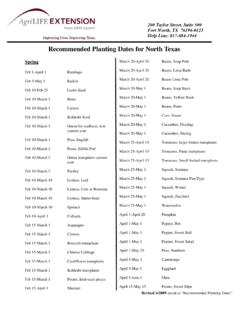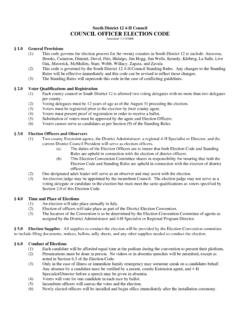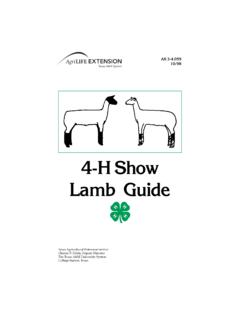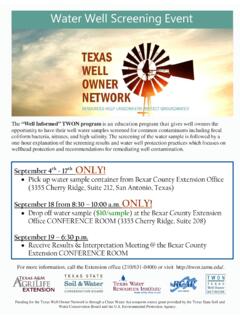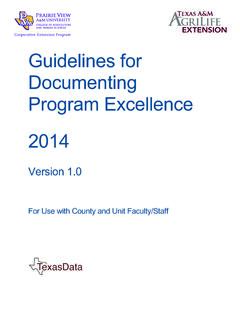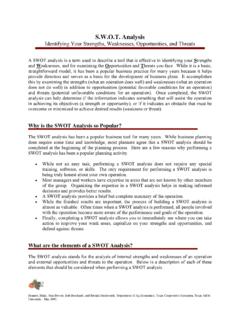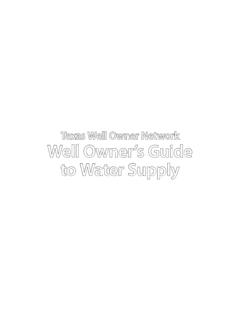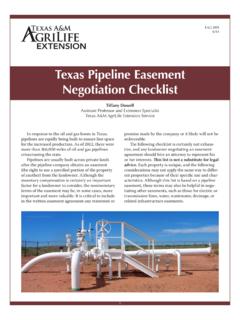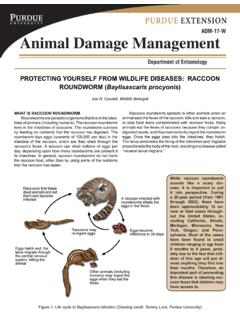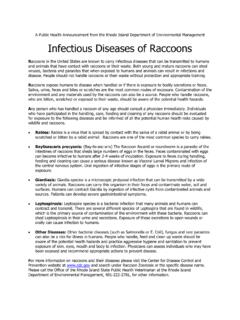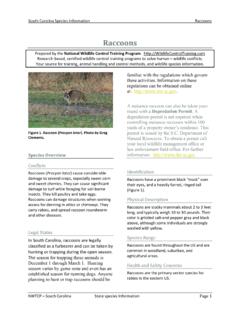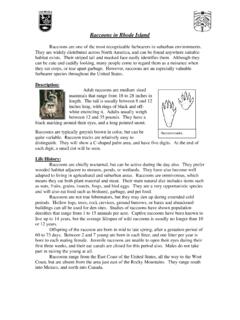Transcription of 4-08 Controlling RACCOON Damage
1 raccoons (Procyonlotor) are common through-out much of the United States and are impor-tant furbearers. In the wild, they prefer livingnear streams, rivers, lakes and marshes, and theyrequire trees, brush and other cover. They usuallymake their homes in hollow trees, logs, rockycrevices or abandoned armadillo are opportunistic feeders, takingwhatever is available. Fruits, berries, acorns,insects, fish, mollusks, grasshoppers, mice, birds,snakes, eggs and crayfish make up the bulk of theirdiet. They also feed on corn, sorghum and othercultivated farm are intelligent and can adapt readilyto living in close association with people. They arevery common in urban areas, but since most oftheir foraging is done at night, they often go unde-tected. In urban communities, raccoons live virtu-ally any place that offers protection.
2 The most com-mon sites are in attics and chimneys, or underhouses and woodpiles. Since raccoons are omnivo-rous, there is a wide variety of food available tothem in urban areas. Dog and cat food, fruit trees,vegetables in home gardens, and trash can garbagesupply an easy can cause considerable Damage . Inrural areas, they may raid poultry houses, feed onfarm crops, and may kill young lambs and kidgoats. In urban areas, Damage occurs mainly toattics and roofs, but other Damage may includeruining gardens, eating fruit on trees, digging upyards, or exposing people or pets to transmissiblediseases. Several different types of parasites anddiseases affect raccoons such as fleas, ticks, lice,roundworms, tapeworms, distemper, tuberculosis,mange and is the most satisfactory way to removeraccoons.
3 In urban areas, it is advisable to use cagetraps. This allows pets, if accidently caught, to bereleased. A cage trap, either constructed or pur-chased from a feed or hardware store, with dimen-sions of at least 10 inches x 12 inches x 36 inches isadequate. Bait these traps with fruit, chicken parts,sardines or meat. When placing the traps outside,L-19024-08 BiologyandReproductionAdult weight: 10 to 30 length: 26 to 38 : Grayish brown body with black maskacross face and black rings around thefurred : Five elongated period: 63 size: Three to of litters: One litter per year,usually born in February or Span: Up to 12 fruit for bait reduces the likelihood of catch-ing cats or small dogs. Place the trap on a sheet ofplywood or similar surface because raccoons nor-mally dig up grass or anything else within reachand pull it into the rural areas, leghold traps may be more desir-able.
4 Several kinds of sets are used successfully tocatch raccoons . The dirt-hole set is one of the the trap about1 2inch below the ground, 1 or 2feet from the side of a trail, and cover it lightly withsifted soil. Cover the trap pan with a piece of tissueor canvas before sifting dirt over it to prevent dirtfrom getting underneath and locking the trap a small hole, about 6 inches deep and 3 inchesacross, at a slant just behind the trap. raccoons areattracted to a dirt hole set with a gland lure in thewinter and early spring, and with a food lure therest of the year. Both lures are available from trap-ping equipment suppliers. Be sure the trap chain isfastened securely to a stake or cubby set is useful especially in winterbecause it protects the trap, but it may be used inany season.
5 Make a triangular house with largesticks or small logs about 1 foot high and 2 feetdeep. Cover the top with boughs or sticks andleaves. Hide the trap just inside the open end andplace the bait behind it. A cubby set also may bebuilt with two open ends, with a trap in each endand bait in the middle. Use of a drag instead of astake is desirable so that the cubby set will not bedestroyed by a trapped sets are popular in many places, particu-larly in marshy areas or along streams. The mainadvantage of the water set is that it is easy to placethe trap without arousing the suspicion of the rac-coon. Place the trap 2 or 3 inches beneath the sur-face and about 5 or 6 inches from the shore. Coverthe jaws of the trap and trap chain lightly with finesilt; do not use bait.
6 Attach a bright shiny object(such as a bright button or aluminum foil) to thetrap pan. The RACCOON s curiosity causes him toinvestigate the shiny object on the trap pan. Such alure also can be used on land sets near are no repellents, toxicants or fumigantscurrently registered for RACCOON raccoons are a problem, several thingscan be done to discourage them. Screen chimneysand attic and foundation vents to prevent animalsfrom getting in or under the house. Reducing thefood and water supply also helps to discourage rac-coons. Feed pets in the morning and clean up allleftovers. Empty water bowls at night or place themout of the raccoons reach. Take bird feeders in atnight or place them on tall poles and away fencing does not keep raccoons out ofgardens or poultry houses.
7 If they cannot go underor through a fence, they climb over. However, rac-coons and most other small animals may berepelled by adding a single electrified wire strand toa fence. Place the wire 8 inches from the fence and8 inches above the prevent burrowing beneath a fence, bury a2-foot wire mesh so it extends 6 inches below thesurface and 18 inches outward at that the four basic rules for controllingraccoon Damage : 1) remove food supply; 2) removewater supply; 3) modify habitat; 4) trap are classified as furbearers in Texas;however, it is legal to trap them. Under state law, aperson may trap a furbearing animal at any time ifit is causing Damage or creating a nuisance; howev-er, the pelt can be sold only during the furbearerseason and with the proper licenses.
8 Other furbear-ers include beaver, otter, mink, ringtailed cat, bad-ger, skunk, nutria, weasel, opossum, muskrat, foxand civet wishing to live-trap raccoons andrelocate them after they have been caught mustnotify representatives of the Texas Parks andWildlife additional information contact the nearestoffice of the Texas AgriLife Extension Service Wildlife information given herein is for educational purposes only. Reference to commercial products or trade names is made programs are open to all people without regard to race, color, sex, disability, religion, age, or national Services is a program of the Texas A&M AgriLife Extension Service cooperating with the United States Department of Agriculture Animal and Plant Health Inspection Service Wildlife A&M AgriLife Extension Service Wildlife Services Box 100410 San Antonio, Texas 78201-17101M, Reprint
